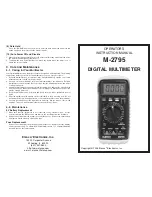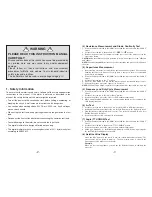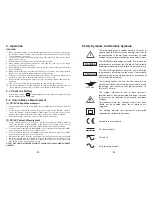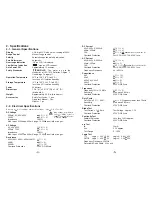
1. Safety Information
To ensure that the meter is used safely, follow all of the safety and operation
instructions in this manual. If the meter is not used as described in the
manual, the safety features of the meter might be impaired.
• Turn off the power to the circuit under test before cutting, unsoldering, or
breaking the circuit. Small amounts of current can be dangerous.
• Use caution when working above 60VDC or 30VAC rms. Such voltages
pose a shock hazard.
• When using the test lead, keep your fingers behind the guards on the test
lead.
• Disconnect the live test lead before disconnecting the common test lead.
• To avoid damage to the meter, do not exceed the input limits.
• This digital multimeter is designed for indoor use only.
• This digital multimeter has a measuring deviation of 2.3% by immunity test
according to EN50082-1.
(3) Resistance Measurement and Diode, Continuity Test
1. Connect the black test lead to the “COM” socket and the red test lead to the “V
W
CAP”
socket.
2. Set the selector switch to the desired “
W
”, “ ” or “ ” position.
3. Remove the power from the equipment under test, connect the probes across the
circuit to be tested.
CAUTION: Be sure that the circuit to be tested is “dead”. Max. input overload: 250Vrms
and <10sec.
NOTE: When testing 400M
W
resistance, short the test leads and press the “REL” button,
then test.
(4) Capacitance Measurement
1. Before testing, discharge the capacitor by shorting its leads together. Use caution in
handling the capacitors because they may have a charge on them of considerable
power before discharging.
2. Connect the black test lead to the “COM” socket and the red test lead to the “V
W
CAP”
socket.
3. Set the selector switch to the “F” position.
4. Press the “REL” button. You can use the relative function to eliminate the zero error.
5. Connect the probes across the capacitor to be tested.
NOTE: When testing a 200
m
F capacitor, note that there will be approx. 30 sec. time lag.
(5) Frequency and Duty Cycle Measurement
1. Connect the black test lead to the “COM” socket and the red test lead to the “V
W
CAP”
socket.
2. Set the selector switch to the “Hz” or “Duty” position.
3. Connect the probes across the source or load under measurement.
4. When using the 80KP-2 Adapter, the correct reading should be the reading on the
LCD display times 128.
(6) h
FE
Test
1. Set the selector switch to the desired “h
FE
” position (PNP or NPN type transistor).
2. Never apply an external voltage to the h
FE
sockets. Damage to the meter may result.
3. Plug the transistor directly into the h
FE
socket. The socket is labeled E, B, and C for
Emitter, Base, and Collector.
4. Read the h
FE
(beta or DC current gain) in the display.
(7) Logic (TTL/CMOS) Test
1. Connect the black test lead to the “COM” socket and the red test lead to the “V
W
CAP”
socket.
2. Set the selector switch to the desired “TTL” or “CMOS” position.
3. Connect the probes across the source or load under measurement.
4. With a logic high pulse (1), the indicator will display on LCD. With a logic low pulse
(0), the indicator will appear on the LCD.
(8) Relative Value Display
Press the “REL” button on the meter to use the relative measurement mode. The
present value will be stored in memory.
The new display value is equal to the
measurement value minus the stored value.
Example:
When you test the capacitance, you can use the Relative function to eliminate the
zero error.
!
WARNING
!
PLEASE READ THIS INSTRUCTION MANUAL
CAREFULLY
Misuse and/or abuse of this instruction cannot be prevented by
any printed word and may cause injury and/or equipment
damage.
Please follow all these instructions and measurement
procedures faithfully, and adhere to all standard industrial
safety rules and practices.
The multimeter shall be used in over voltage category II !
-2-
-7-






















